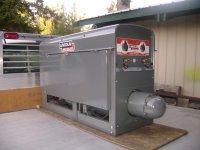Hi, I never welded but I'm thinking to give it a try. The point is that I know nothing more that what I could find in the pages of the various manufacturer of welding machines. I will use the welder on tractor related equipment and therefore on 1/2 inch of iron or more.
I was initially considering a stick welder now I'm thinking of a MIG welder. My question is: a MIG welder rated for 1/8 or 3/16 thick iron will weld a thicker iron? Will eventually the weld be good? I'm not so much interested in speed of welding since it will be more of a hobby.
Also, which are the difference between a Miller and an equivalent Hobart (I believe they manufactured by the same company).
thank you very much.
Hello, Sevilla. I do a lot of welding (self-employed, so not really 'professionally' so I'm not citing scripture here) and here's what I have learned. I use two Miller wire welders (a 'matic 210 and 212) for most of my work, but I also have and swear by my Hobart Stickmate LX AC/DC. With the wire welders I weld from 1/8" to 1/4" mild steel. No problems, even not at the max output from either one. Caveat: nobody x-rays my welds or checks that they meet any standards at all other than the products I make don't fall apart on the hiway or the farm. You can get a 'matic 212 or equivalent for about $1,800 MSRP (less is easily done, but not a whole lot, maybe $1,500?). You need a bottle of shield gas and I recommend the lube pads. You can get an AC/DC Hobart Stickmate LX (I think that's still the current model) for about $500 MSRP and less at Tractor Supply or elsewhere. No gas. You can buy all kinds of rods to weld cast iron (useful on tractor equipment sometimes), aluminum (I've done it), mild steel, and stainless steel. You can also get hard surfacing electrodes which is useful for impact parts and ground-engaging areas of implements. You can weld more than 15 feet from the welder easily with longer leads.
With wire you get good travel speeds and good weld appearance (hint: buy the anti-spatter spray) but it helps if the metal is clean; paint and moderate rust can be a problem. But you're going to need to control the wind/breezes so they don't blow your shield gas way (unless you use flux-core). You can't weld more than about 15-18 feet from the machine becuase, as I see, that's about the longest gun lead they make (without push-pull). You can weld mild steel easily, right out of the box. You can weld stainless steel, and maybe other materials (other than aluminum) without having special accessories but you'll have to change the wire for each different material (a time-consuming process). For aluminum you'll need different shield gas and a spool gun or push-pull.
With stick you get good travel speeds and variable apperance depending on the electrode. You will need to remove the flux slag from the welds for appearance and to eliminate voids where water can trap to form rust. You can weld all kinds of materials and do different tasks easily, just change the electrode/settings. Aluminum, stainless, hard-surfacing, cast, no sweat. Outdoors, windy, 100 feet from the welder, no problem.
If you're going to buy one welder, buy a stick welder and learn to use it. 6011 and 6010 rods for general purpose mild steel work. Buy an AC/DC unit, not just AC as some rods (6010/7018) require/recommend DC. Use quick connects to make moving things around easier so you're not dragging leads at the same time you're moving the welder. Learn which polarity the rods are recommended/designed for.
What I see, personally, different in the seemingly-identical Miller vs Hobart welders is that the AC/DC verrsion of the Hobart claims, IIRC, a maximum output of 160/225 amps, DC/AC respectively, and the Miller claims 150/215 or so amps, DC/AC respectively. Also, you can buy your Hobart from Tractor Supply right off the shelf instead of the Miller which means you have to go to a welding supply store (or somewhere online).
Not that it's much of a question anymore, but buy a good auto-darkening helmet that has variable shades and a "grind" setting. I use the "grind" setting for all my Oxy/acetylene work and love it. Hobart makes one...a someting VXP or some such. Tractor Supply used to carry them but I don't think so anymore. I had a Jackson 3N1 before and it was okay but at about 400 bucks it was not as good a bang-for-the-buck deal as the last VXP (or whatever that model was...wish I could remember for sure) I got for $150 from Tractor Supply.
Oh, and wear long-sleeves...arc welding will give you a nasty sunburn.
--HC

